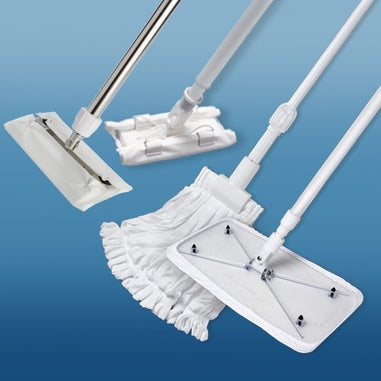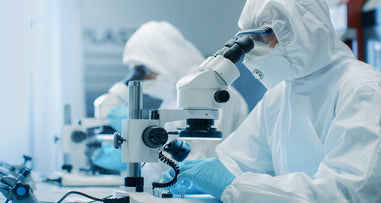- No products in the cart.
Maintaining cleanliness in a cleanroom environment is paramount for industries ranging from pharmaceuticals to electronics manufacturing. One of the essential tools in this endeavor is the cleanroom mop. However, with a plethora of options available, choosing the right mop can be overwhelming. In this comprehensive guide, we'll delve into the various factors to consider when selecting cleanroom mops, providing actionable advice for optimizing your cleanroom cleaning protocols.
Understanding Cleanroom Classifications
Cleanrooms are categorized based on their air cleanliness level, as defined by the ISO 14644-1 standard. This standard outlines the maximum allowable concentration of airborne particles at a specific size. Common classifications include:
- ISO 1/ISO 3 (Class 10/Class 1): The most stringent environments, used for critical applications like aseptic filling in pharmaceuticals.
- ISO 4/ISO 5 (Class 100/Class 1000): Essential for operations involving high-value components like microelectronics.
- ISO 7 (Class 10,000): Widely used for pharmaceutical manufacturing, medical device assembly, and optics production.
- ISO 8 (Class 100,000): Suitable for less critical applications where moderate contamination control is necessary.
Factors to Consider When Choosing a Cleanroom Mop
Several factors influence cleanroom mop selection. Here are the key considerations:
-
Material Compatibility: Cleanroom mops must be constructed from materials that are low in particle shedding and compatible with disinfectants used in your facility. Common materials include microfiber, knitted polyester, and nonwoven fabrics. Micropolyester offers excellent absorbency and particle capture, while nonwoven fabrics are known for low-linting properties.

-
Mop Head Size and Construction: The size of the mop head should correspond to the cleaning area. For large open spaces, larger heads increase efficiency. For confined areas or navigating around equipment, a smaller head is more maneuverable. Mop heads come in flat or loop-ended styles. Flat mops offer better cleaning under furniture and edges, while loop-ended mops are efficient for general floor cleaning.
-
Mop Frame and Wringer Compatibility: Mop frames should be lightweight and constructed from non-shedding materials like anodized aluminum or static dissipative plastic. Ensure compatibility between the mop head and wringer system to avoid damage during laundering. Opt for wringers with closed systems to minimize the release of contaminated cleaning solution.
-
Cleanroom Classification: The required level of contamination control dictates the mop selection. Higher classifications (ISO 1-5) necessitate mops specifically designed for low particle shedding. These mops often utilize features like heat-sealed edges and double-bagged laundering processes. For less critical environments (ISO 7-8), standard cleanroom mops may suffice.
-
Surface Type: Consider the floor surface in your cleanroom. For smooth, sealed floors, microfiber mops excel at trapping particles. For rougher surfaces like epoxy or conductive floors, looped mops with textured yarns may be more effective.
-
Disinfectant Compatibility: Ensure the mop material is compatible with the disinfectants used in your cleaning protocols. Some disinfectants can degrade certain fabrics, reducing mop lifespan and potentially impacting cleaning efficacy.
Matching Mop Heads to Specific Needs
Here's a quick guide to pairing mop heads with cleanroom classifications and surface types:
- ISO 1-5 Cleanrooms & Smooth Floors: Opt for low-linting, heat-sealed microfiber mops.
- ISO 7-8 Cleanrooms & Smooth Floors: Microfiber or knitted polyester mops are suitable choices.
- ISO 1-5 Cleanrooms & Rough Floors: Consider looped mops with textured yarns for better particle capture.
- All Classifications & ESD-Safe Environments: Look for mops constructed from static dissipative materials to prevent electrostatic discharge (ESD) events.
Optimizing Cleanroom Cleaning Protocols with Mops
- Pre-wetting: Always pre-wet the mop head with disinfecting solution in a designated cleanroom bucket. This reduces particle generation during mopping.
- Double-Bucket System: Employ a two-bucket system – one for cleaning solution and another for rinsing. This minimizes cross-contamination.
- Directional Mopping: Develop a consistent mopping pattern to ensure complete floor coverage and avoid spreading contamination.
- Mop Laundering: Follow manufacturer's instructions for laundering cleanroom mops. Many require special processes like cleanroom laundry services to maintain their low particle-shedding properties.
- Mop Rotation: Regularly rotate mops to prevent them from becoming saturated with contaminants. Discard or launder mops according to established protocols.
- Training: Provide thorough training to cleaning personnel on proper mop selection, use, and disposal techniques. This promotes consistent cleaning practices and minimizes the risk of contamination.
Regular Evaluation and Adaptation
Cleanroom cleaning protocols should be periodically evaluated and adapted based on changing requirements or advancements in technology. Regularly assess the performance of your cleanroom mop and make adjustments as needed to ensure optimal cleanliness and compliance with industry standards.
Elevate Cleanliness Standards with Texwipe Cleanroom Mops from Lab Pro
When it comes to cleanroom mops and mop heads, Texwipe is a leading name trusted throughout the industry. Texwipe offers an extensive array of cleanroom mop solutions meticulously designed to meet the rigorous demands of controlled environments. Crafted from high-quality materials such as microfiber and polyester, Texwipe's mop heads ensure exceptional particle retention and long-lasting durability. Available in various sizes and configurations to accommodate different cleanroom applications and surface types, Texwipe remains a preferred choice for cleanroom cleaning solutions. Now, you can conveniently purchase Texwipe cleanroom mops through Lab Pro, your trusted source for premium cleaning supplies. With Texwipe's unwavering focus on quality and innovation, integrating their cleanroom mops and mop heads into your cleaning protocol can enhance efficiency and uphold the highest standards of cleanliness in your facility.
Conclusion
Selecting the right cleanroom mop is a crucial step in maintaining a controlled environment. By considering the factors outlined above and tailoring your choices to your specific cleanroom needs, you can optimize your cleaning protocols and ensure a contaminant-free environment for your sensitive operations. Remember, a well-chosen mop, combined with proper procedures, plays a vital role in safeguarding
For over 45 years, Lab Pro Inc. is your steadfast source for premium cleanroom mops, hand tools, lab equipment, chemicals, and PPE apparel. Trusted by aerospace industries, medical device companies, and laboratories globally, we epitomize exceptional quality in every product. Experience the convenience of next day service in California. Contact us online or at 888-452-2776 to explore solutions tailor-made for the laboratory industry. Elevate your experiments with Lab Pro Inc. – your partner in precision and excellence.












































